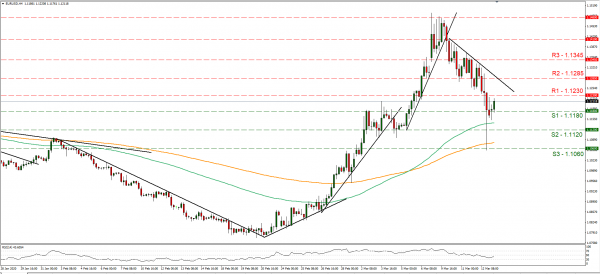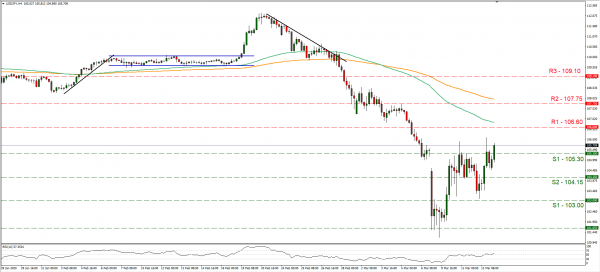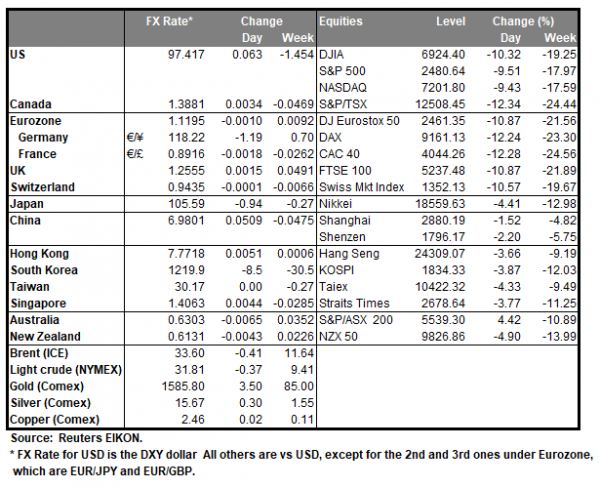The USD strengthened against all its major counterparts yesterday, as investors scrambled for safety in the world’s most liquid currency in face of one of the stock-markets’ worst sell-off since 1987, as per analysts. The Federal Reserve moved to provide $1.5 trillion in short-term liquidity and changed the durations of Treasuries it buys, however markets may expect even more from the Fed to calm the markets. Analysts note that the markets are acting in panic mode because it is not foreseeable how far stocks could fall. We would like to add that such a market mood would tend to enhance the negative interpretation of any developments, until the markets realize that they are at too low levels, irrespective of what could actually trigger such a change of direction. It should be noted that senior officials of the G7 group talked on Thursday and confirmed that they cooperate closely. Markets seem to already eye the Feds’ meeting next week in order for any clues about how far the bank would go in order to support the markets. USD/JPY rose and during today’s Asian session broke clearly the 105.30 (S1) resistance line, now turned to support. We could see the pair continuing to rise should the USD continue to be the main recipient of safe haven inflows and outperform JPY as a safe haven. Should the bulls maintain control over the pair, we could see it breaking the 106.60 (R1) resistance line aiming for higher grounds. Should the bears take over, we could see the pair breaking the 105.30 (S1) support line and aim for the 104.15 (S2) support level.
ECB remained on hold, yet the EUR weakens
Despite wide market expectations for a 10 basis points rate cut by the ECB, for its deposit rate, the bank remained surprisingly on hold. It should be noted that in its accompanying statement the bank underscored that it does not see “material signs of strains in money markets or liquidity shortages in the banking system”. On the other hand, one must note that the strong measures especially the additional purchases of bonds of 120 Billion euros in the next ten months along with TLTRO’s with interest rate of 25 basis points below the deposit rate could constitute a rate cut in disguise as analysts mentioned. In her press conference later on, the ECB President Christine Lagarde once again urged governments to come up with an “ambitious and coordinated fiscal response … to support businesses and workers at risk”. We could see the EUR weakening further in the aftermath of the decision, yet interest rate differentials may benefit the EUR against the USD in the long term as the Fed is expected to proceed with further cuts. EUR/USD tumbled yesterday and breaking the 1.1285 (R2) and the 1.1230 (R1) support lines, now turned to resistance. As the pair’s price action remains below the downward trendline incepted since the beginning of the week, we maintain a bearish outlook for the pair. Should the pair continue to be under the selling interest of the market, we could see it breaking the 1.1180 (S1) support line and aim for the 1.1120 (S2) support level. Should the pair’s long positions be favoured by the market, we could see it breaking the 1.1230 (R1) resistance line and aim for the 1.1285 (R2) resistance line higher grounds.
Other economic highlights today and early tomorrow
Today during the European session, we get the final reading of Germany’s HICP rate and France’s CPI (EU Normalized), both for February. In the American session we get the preliminary Un. Of Michigan consumer sentiment for March reading as well as the Baker Hughes oil rig count. During Monday’s Asian session, from Japan, we get the machinery orders growth rate for January and from China we get the industrial output growth rate as well as the retail sales growth rate, both for February. As for speakers, during Monday’s Asian session, RBA’s Alexandra Heath speaks.
Support: 1.1180 (S1), 1.1120 (S2), 1.1060 (S3)
Resistance: 1.1230 (R1), 1.1285 (R2), 1.1345 (R3)
Support: 105.30 (S1), 104.15 (S2), 103.00 (S3)
Resistance: 106.60 (R1), 107.75 (R2), 109.10 (R3)

















